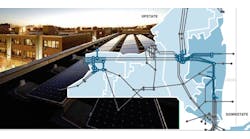More and more, utilities are deploying behind the meter (BTM) assets — particularly energy storage and electric vehicles (EV) — to reduce their loads, balance their systems and provide resilience.
In the wake of a February outage, Portland General Electric said it has been testing projects that deploy customer sited storage to help boost resilience during storms and emergencies.
Third party aggregators are also offering behind the meter assets to help stabilize the grid and help during shortages. For example, in August, a network of home microgrids and networked home appliances controlled by OhmConnect provided 220 MWh to the California Independent System Operator as a generating resource during rolling blackouts.
Now comes a Texas study by Pecan Street, “Behind the Meter Storage and 4CP in Texas,” demonstrating the benefits and challenges of deploying customer sited storage and EVs in Austin Energy’s territory under ERCOT’s 4 Coincident Peaks (4CP) reduction program, which creates incentives for utilities to reduce their peak load.
The study, which was conducted in 2019, had mixed results that underlined some of the challenges — such as high temperatures that boost the operating temperature of energy storage systems beyond manufacturers’ specifications — that can be addressed in future projects, in Texas and elsewhere.
Microgrids can expand scale of energy savings
Behind the meter microgrids that incorporate EVs and energy storage also can be used to reduce utility load, balance the grid, provide resiliency and save utilities money.
“Our research found that behind the meter battery storage can result in significant savings for utilities. Microgrids can also reduce load during critical peak events, potentially at an even greater scale than standalone battery storage,” said Pecan Street’s CTO Scott Hinson.
The good news that came from the study: Deploying behind the meter batteries and EVs in June, August and September 2019 reduced Austin Energy’s peak load by 40 kW, yielding a $2,400 savings over the three months, assuming $60 for each kW of savings.
The challenges, however, included deploying the batteries on very hot summer days when the batteries — mounted on the outside of residential customers’ garages — were too hot to deploy according to manufacturers’ recommendations.
Cutting trees caused problems
What’s more, some customers cut down trees that shaded the units, which increased their temperatures. Another issue the study uncovered was the need to charge the batteries before peak periods occurred — in this case, in the morning. In one instance, the batteries were charged during peak events, increasing peak demand and utility costs.
The project looked at the benefits of BTM assets that can lower a utility’s net transmission cost through ERCOT’s 4CP reduction program. This methodology is the Electric Reliability Council of Texas’s (ERCOT) way of assigning transmission system costs to distribution utilities. “By assigning transmission costs as a percentage of peak load, the charge serves as an economic incentive to reduce peak demand,” according to a summary of the project. “If an electric utility reduces its load during a 4CP event, it can reduce its share of transmission costs for the following year.”
In the summer and fall of 2019, Pecan Street deployed seven stationary residential batteries and one bidirectional EV, which amounted to 45 kW of dispatchable load that could reduce Austin Energy’s load during peak events, according to the report.
This was part of Austin Energy’s Austin Sustainable and Holistic Integration of Energy Storage and Solar Photovoltaics (SHINES) program, which aims to optimize the value stream for solar and storage using a model developed for grid, commercial and residential applications. The project includes two utility scale energy storage systems, multiple systems at residential and commercial sites, smart inverters, real-time data feed, a distributed energy resource optimizer and a vehicle-to-grid component.
Funding comes from federal, state and city sources, including the US Department of Energy Solar Energy Technology Office, the Texas Commission on Environmental Quality, a New Technology Implementation Grant and Austin Energy.
Pecan Street served as the residential aggregator for Austin SHINES, deploying the residential batteries and vehicle-to-grid EV in Austin.
The system deployed by Pecan Street included seven two-hour, 5 kW batteries attached to the outside of homes located in Pecan Street’s volunteer research network in Austin. The system also included one four-hour, 10 kW bidirectional vehicle-to-grid EV located at Pecan Street’s lab. They total 45 kW of capacity.
Understanding costs and benefits of behind the meter assets
“The project goal was to understand the costs and benefits of residential, commercial and utility scale battery systems,” said the report. The project evaluated six battery control applications, looking at market value, reliability and customer value. For market value, the applications studied were utility peak load reduction, day ahead energy arbitrage and real time price dispatch, according to the report.
For reliability, the project looked at voltage support and distribution congestion management applications. And for commercial customer value, the project analyzed monthly demand charge reductions.
In the past, most 4CP events have taken place between 3:45 p.m. and 5 p.m. Two-hour battery systems were deemed appropriate for this project.
The project yielded different results depending on outside temperatures and the ability to predict when batteries should be deployed.
Join Microgrid Knowledge for Microgrid 2021: The World Awakens to Microgrids, a virtual conference spanning eight days in May and June. Participation is free if you register in advance. See the agenda and speakers here.
In June and September 2019, the systems were controlled by Doosan’s management platform, Distributed Energy Resource Optimizer, and reduced Austin Energy’s utility peak by 30 kW and 10 kW, respectively.
During the June event, Austin Energy’s load was 2,544.43 MW. Six residential systems were charged and available to reduce the peak load, allowing Austin Energy to reduce load by 30 kW and save $1,800.
In July, the systems weren’t charged enough in time for the 4CP event. In August, during hot days, Pecan Street removed the batteries from the aggregation projects because temperatures were approaching the manufacturer’s specified maximum operating temperature of 108 degrees Fahrenheit.
“The control platform called for charge commands of the batteries, planning for a future peak or charging the assets again after meeting a peak sooner in the afternoon,” said the report.
By Lucky Team Studio/Shutterstock.com
Sometimes things go the wrong way…
As a result, charging the systems caused Austin Energy’s total load to increase by 13 kW.
If the systems had been charged earlier in the day, load reduction could have been 35 kW. This would have saved Austin Energy $2,100, but, instead, charging the batteries cost the utility $780. Pecan Street concluded that simpler rules-based limits that prevented charging during likely 4CP events would help avoid charging during peak load events.
In August, the 4CP event occurred between 4:45 p.m. and 5:00 p.m. Because of high temperatures, most of the storage units were idled and removed from the aggregator. Pecan Street didn’t want to operate the storage outside of manufacturers’ specified temperatures.
“As a result, there was no value added from the residential [energy storage] assets,” said the report. On September 9, the outdoor systems were removed from the aggregator because of high temperatures.
At the time, only the 10 kW EV battery, stored in a garage, was helpful.
Standards needed
“This suggests the need for installation standards that provide protection from the elements in order to have higher availability during weather extremes,” the report said. While Pecan Street mounted the batteries on shaded exterior walls, some residents cut trees that provided shading.
“Pecan Street’s work with the Austin SHINES project suggests that behind the meter storage assets can provide valuable grid services, such as peak load reduction when aggregated or with further reductions in price,” said the report.
The study provides valuable information for utilities and behind the meter asset providers that can be used to cut utility costs, boost resilience and support the grid.
Track news about behind the meter assets, including microgrids, energy storage and electric vehicles. Subscribe to the free Microgrid Knowledge Newsletter.








